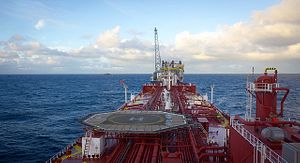On July 26, the World Bank raised its 2016 forecast for crude oil prices to $43 per barrel from $41 per barrel previously, on the back of supply outages and “robust demand” in the second quarter.
Oil prices surged by 37 percent in the second quarter 2016 due to supply disruptions, including Canada’s wildfires and the sabotage of oil infrastructure in Nigeria.
“We expect slightly higher oil prices for the second half of 2016 as oil market oversupply diminishes,” senior economist John Baffes said in the bank’s latest “Commodities Markets Outlook.”
“However, inventories remain very large and will take some time to be drawn down.”
Yet while Brent crude prices have risen by 15 percent in 2016, prices are still 13 percent lower compared to a year ago, with Saudi Arabia and Iran now engaging in a battle for market share. Meanwhile, Asian demand for crude has dropped as refineries in China, Singapore and South Korea cut operating rates amid lower margins and rising supply, according to Bloomberg News.
The World Bank still sees most commodities declining this year due to “persistently elevated supplies” and weaker growth prospects in a number of emerging and developing economies. The Washington-based institution expects energy prices to fall by 16.4 percent this year, while non-energy commodities such as agriculture and minerals are seen falling by 3.7 percent, compared to its April projections of a 19.3 percent and 5.1 percent decrease, respectively.
The weaker fall in energy prices will reduce the downturn in food prices, since energy accounts for more than 10 percent of the cost of agricultural production. The bank said lower harvests in South America and reduced demand for biofuels would help ease the downturn in agriculture prices.
For much of Asia though, the rebound in the price of oil from $27 a barrel in January to its current price of around $40 has served to reduce the threat of global deflation substantially, according to ANZ Research.
In a July 29 report, the Australian bank said fundamentals would drive prices toward US$54 by year-end, helping “see the end of deflation in Asia.”
“In fact, the inflation rates of most Asian economies have gone up in the past six months. Producer prices in China and wholesale prices in India have improved by more than 2.5 percentage points,” ANZ said.
The change in headline inflation rates has been led by Chinese producer prices, followed by India’s wholesale prices and then Vietnam and Thailand’s consumer prices. According to ANZ, China’s producer price index could turn positive in the second half of 2016 after four years of contraction, while recent floods should see higher fruit and vegetable prices in coming months.
The significance of oil for Asian prices is its large representation in production costs for many consumer items, such as clothing, food and transportation costs. According to ANZ, energy, food and clothing and apparel constitute more than half of India’s consumer price index (CPI) basket, and more than 60 percent of the CPI basket in both the Philippines and Indonesia.
Although global commodity prices remain subject to the risk of a faster slowdown in Chinese investment demand, more aggressive U.S. Federal Reserve tightening and geopolitical conditions, ANZ said even a drop in the oil price to around $30 a barrel would not dent its forecasts.
Higher commodity prices are also a positive for Australian inflation, which according to Nikko Asset Management (Nikko AM) has fallen in line with the end of the mining boom but now shows signs of picking up.
“If the recent stabilization in commodity prices can continue, then this would suggest the low point for inflation could be closer than expected. While inflation will likely remain low for some time, this recent stabilization in commodities means that the risk of inflation falling below 1 percent [in Australia] is reduced. In our view, it is now more likely that it will rebound higher, albeit moderately, over the next six months,” Nikko AM’s Chris Rands said.
Higher oil prices may hit consumers but could help efforts by the Bank of Japan (BOJ) to revive inflationary expectations in the world’s third-largest economy. In a July 30 statement, the nation’s central bank said the CPI would likely remain slightly negative or at zero for the time being, “due to the effects of the decline in energy prices,” but should accelerate toward its 2 percent target by fiscal 2017, helped by an expected upturn in crude oil prices.
The BOJ disappointed investors Friday with its decision to maintain negative interest rates and bond buying at their current level, while increasing purchases of exchange-traded funds to 6 trillion yen ($59 billion) from 3.3 trillion yen previously. But while the move saw the yen strengthen and stocks weaken initially, signs are emerging of a change in inflationary expectations, at least among consumers.
According to UBS economist Paul Donovan, Japanese consumers’ expectations of inflation are now around 4 percent a year – twice the official target and the highest in the developed world.
“In one sense, if the 2 percent inflation target of the Bank of Japan was aimed at raising inflation expectations, the Bank of Japan has succeeded. Bank of Japan Governor [Haruhiko] Kuroda should get a banner made saying ‘mission accomplished’…[although it] is still dealing with a deflationary economy” with companies cutting prices, he told the Nikkei Asian Review.
After Japan’s recent experience, the rest of Asia should not be relaxing anytime soon about having vanquished the bugbear of deflation. But with higher oil prices on the horizon, the region’s central bankers might finally be able to get back to their real jobs of helping grow their economies, and along with it the rest of the world.

































